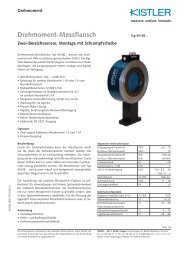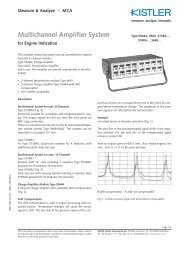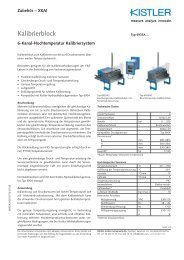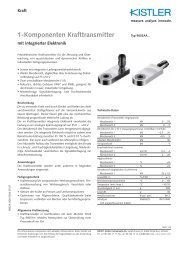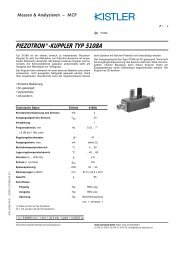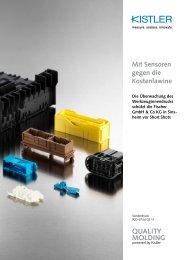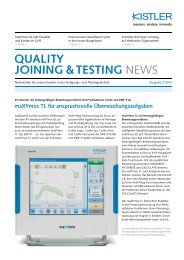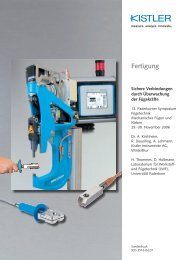Quality Joining & Testing News 2/12 - Kistler
Quality Joining & Testing News 2/12 - Kistler
Quality Joining & Testing News 2/12 - Kistler
You also want an ePaper? Increase the reach of your titles
YUMPU automatically turns print PDFs into web optimized ePapers that Google loves.
maXYmos BL Keeps <strong>Quality</strong> and<br />
Costs under Control<br />
> Page 2<br />
Torque Measuring Flange Now<br />
in Three New Sizes<br />
> Page 5<br />
&<br />
Fast ROI after Switching to Electric<br />
<strong>Joining</strong> Systems<br />
> Page 6<br />
NEWS<br />
Important news for our customers in manufacturing and assembly Issue 2/20<strong>12</strong><br />
XY monitor with powerful evaluation techniques replaces CoMo and DMF-P product series<br />
maXYmos TL for Challenging Monitoring Applications<br />
Building on the positive response to the<br />
XY monitor maXYmos BL for process monitoring<br />
and product testing, <strong>Kistler</strong> is now<br />
offering this proven successful concept<br />
in the maXYmos TL Type 5877A… with<br />
extended functionality. The maXYmos TL<br />
can be used for simple force-displacement<br />
monitoring through challenging applications<br />
in assembly and product testing.<br />
Starting in 2013, the top-level version will<br />
incrementally replace the ControlMonitors<br />
CoMo Logic, CoMo Sys, CoMo View<br />
and CoMo Net as well as the DMF-P<br />
A300 and DMF-P A400.<br />
maXYmos TL with powerful evaluation<br />
techniques<br />
The extensive functionality and straightforward<br />
operating concept using an intelligent<br />
menu system are based on the<br />
maXYmos BL. Key features of this highend<br />
XY monitor are more powerful evaluation<br />
techniques, a larger selection of<br />
connectable sensors, unrestricted choice<br />
of fi eldbus types, expandability up to 8<br />
pairs of XY-channels and a large (10,4"),<br />
high-resolution, color touch screen display.<br />
Using the additional evaluation<br />
objects (GRADIENT, HYSTERESIS and<br />
CALCULATE), the maXYmos TL ensures<br />
optimal evaluation of even complex curve<br />
criteria. CALCULATE, for example, allows<br />
calculation and evaluation of the distance<br />
between two breakover (snap-in) points<br />
on a force-displacement curve. GETREF<br />
objects provide CALCULATE with the positions<br />
of these points in advance.<br />
The maXYmos TL offers an array of useful<br />
functions to professionals in the fi eld<br />
of process monitoring. The monitor detects<br />
tool breakage with the aid of gradient<br />
monitoring and responds in real time.<br />
The short evaluation time allows moni-<br />
The new high-end XY monitor maXYmos TL provides<br />
powerful functions and evaluation techniques for<br />
process monitoring and product testing
toring of up to 20 parts/second, and the<br />
X- and Y-thresholds can generate switching<br />
signals for control purposes in real time.<br />
<strong>12</strong>8 measurement programs with 10 eval-<br />
uation objects each ensure flexibility in<br />
terms of the evaluation criteria and vari-<br />
ety of parts. A curve memory for NOK<br />
diagnosis provides access to the last 500<br />
curves for analysis using the filter and<br />
bundle function.<br />
Flexible integration into the machine<br />
environment<br />
The maXYmos TL consists of a measuring<br />
and evaluation module (MEM) and a dis-<br />
play module (DIM). The two components<br />
www.kistler.com<br />
can either be installed separately from each<br />
other, so that they are only connected via<br />
the monitor cable, or they can function as<br />
a single compact mechanical and electrical<br />
unit. The latter configuration is achieved<br />
by inserting the MEM into the rear slot<br />
of the DIM. This combination already<br />
provides one pair of measuring channels<br />
(1x XY) and all of the interfaces required<br />
for control, data export and remote main-<br />
tenance. If continual visualization is not<br />
required, the MEM can also function as<br />
a black box module: setup and process<br />
visualization are then handled using VNC<br />
access via the EtherNet or USB interface<br />
in conjunction with the maXYmos PC<br />
Unbeatable value for money for 100 % quality in joining and assembly<br />
The XY monitor maXYmos BL now offers<br />
extended functionality and a still unbeat-<br />
able price-performance ratio as part of<br />
<strong>Kistler</strong>’s product portfolio. With its ad-<br />
ditional capabilities, it is redefining XY<br />
monitoring for joining and assembly<br />
processes as well as product testing. Key<br />
features of the maXYmos BL includes<br />
its intelligent menu system using a 3,5"<br />
color touch screen, highly practical eval-<br />
uation and diagnostic functions, and<br />
universal, modern case concept based<br />
on a modular approach for desktop, wall<br />
and front panel mounting.<br />
The maXYmos BL also includes a large<br />
measurement curve memory for nearly<br />
continuous monitoring of the curve along<br />
with 16 measurement programs for 16<br />
different types of part, each with 4 eval-<br />
uation objects. Automatic trend tracking,<br />
which can be activated for the band of<br />
the envelope curve, tracks the set point<br />
limits, for example with progressive<br />
tool wear, and matches the evaluation<br />
function to the actual process situation.<br />
The internal curve memory and the abil-<br />
ity to display stored families of curves<br />
considerably simplify fault analysis for<br />
the process.<br />
New features are fast data transmission<br />
via serial EtherNet/IP and USB interfaces<br />
as well as the ±10 V input. Fast data<br />
software available as an accessory. The<br />
maXYmos TL is designed to support all<br />
common mounting configurations such<br />
as desktop, wall and front panel mount-<br />
ing. The flexible case concept gives the<br />
machine designer plenty of options. The<br />
MEM is always equipped with Profibus<br />
DP, ProfiNet, EtherNet/IP and Modebus/<br />
IP. Interfaces for all common sensor<br />
types are standard features. <strong>Kistler</strong>’s<br />
product line includes a large selection of<br />
suitable force and torque sensors as well<br />
as displacement and angle sensors. The<br />
maXYmos TL will be available starting in<br />
January 2013.<br />
Get Better. With <strong>Kistler</strong>.<br />
XY Monitor maXYmos BL Keeps <strong>Quality</strong> and Costs under Control<br />
The maXYmos BL Type 5867B… now also for sensors with 10 V output,<br />
with EtherNet/IP bus and USB interface<br />
transmission also enables documenta-<br />
tion of process data for traceability down<br />
to the individual part. The new maXYmos<br />
PC software allows direct transfer of<br />
the test record from the maXYmos BL<br />
to the PC and offers many functions for<br />
visualizing, measuring and analyzing<br />
measurement curves and process values<br />
as well as for evaluating the process<br />
capability.<br />
The maXYmos BL records and interre-<br />
lates all of the measurands that can<br />
be supplied, for example, by force or<br />
torque sensors on the Y-channel and<br />
potentiometric displacement or rotation<br />
angle sensors on the X-channel. It uses<br />
evaluation objects such as BOX, LINE<br />
and ENVELOPE to analyze quality-relevant<br />
sections of the recorded measurement<br />
curves. In this manner, the<br />
maXYmos BL can monitor and evaluate<br />
the quality of a product or production<br />
step. In press-fit processes, for example,<br />
it monitors the force vs. the displacement<br />
or time, and in screw tightening<br />
processes the torque vs. the rotation<br />
angle or time.<br />
XY monitoring can also be used to en-<br />
able very early elimination of rejects from<br />
the process, boost the product and pro-<br />
cess quality, reduce downtime and allow<br />
early detection of tool and system wear.<br />
The measurement results can be fed<br />
back into the process to facilitate pinpoint<br />
process optimization.
Regensburg University of Applied Sciences uses torque measuring flange for Formula Student Electric<br />
KiTorq Sensor Proves its Worth on Electric Motor Test Stand<br />
Regenics e.V. is the Formula Student<br />
Electric team at the Regensburg University<br />
of Applied Sciences. Since 2010, the<br />
student team has used its electric vehicle<br />
to take part in Formula Student Electric<br />
Germany, a competition for young engineers.<br />
In August 20<strong>12</strong>, the 50 students<br />
went with their RP<strong>12</strong>e vehicle to the<br />
German racing track Hockenheimring<br />
for a test run.<br />
Josef Engl, a student at Regensburg and<br />
the team leader for electric drive trains at<br />
Regenics, is in charge of the race car’s<br />
electric motors. In his development work,<br />
he uses a test stand which is equipped<br />
with the new KiTorq torque measuring<br />
flange from <strong>Kistler</strong> with a measuring<br />
range of 500 N·m. "Thanks to the new<br />
design of the torque flange along with<br />
its very short construction, we were able<br />
to make do without a bearing system<br />
between the two motors on our test<br />
stand", reported Engl. "Since we could<br />
bolt the two motors close together on<br />
the flange using the coupling, we were<br />
able to use smaller dimensions for the<br />
shafts with a correspondingly lower<br />
weight."<br />
Since the CoMo Torque evaluation unit<br />
is mobile, the unit that had already been<br />
available at the university for some time<br />
could also be used for the measurement<br />
with the new KiTorq. The stator’s sensor<br />
outputs were connected to a power ana-<br />
lyzer with additional analog and digital<br />
inputs in order to read out the speed<br />
E-motor test stand with KiTorq torque measuring flange from <strong>Kistler</strong><br />
Premiere for the RP<strong>12</strong>e electric vehicle built by the team from Regensburg University of Applied Sciences<br />
and torque and display it with a separate<br />
LabView interface. This online tool helps<br />
to configure the measuring flange and<br />
<strong>Kistler</strong>’s CoMo Torque evaluation unit for torque<br />
sensors in operation (photos: Regenics e.V.)<br />
also to store the torque alarm limits and<br />
various measuring ranges. In this manner,<br />
it was possible to verify the actual<br />
speed using the measuring flange. "Other-<br />
wise, we were only able to measure the<br />
speed via CAN with the power electron-<br />
ics. However, it is a very important control<br />
measuring instrument when setting<br />
up the test stand. Measurement of the<br />
torque on the shaft using the measuring<br />
flange replaces the purely computational<br />
determination of the torque. Based on<br />
the torque and speed, we can automat-<br />
ically compute the power too", reported<br />
Engl.<br />
The motor torque constant (k = torque<br />
t/phase current I) actually acts as a con-<br />
stant over a wide range. "However, a<br />
small non-linearity does creep in especially<br />
for larger values of the torque",<br />
observed Engl. Using the measuring<br />
flange, he was able to determine when<br />
the current no longer behaves directly<br />
proportionally to the torque. Then, he<br />
could create a characteristic and store it<br />
in the power electronics. By measuring<br />
the delay between the specified torque<br />
value (via CAN to the power electronics)<br />
until reaching the torque on the shaft, it<br />
was possible to test various parameters<br />
in the power electronics and obtain ideal<br />
settings.<br />
Based on the comparison between the<br />
electric power and the measured torque<br />
(conversion to power using the speed)<br />
on the mechanical shaft, it was possible<br />
to determine the efficiency of the motor,<br />
the inverter and ultimately the overall<br />
system. Furthermore, the torque/speed<br />
characteristic was recorded at load steps.<br />
www.regenics.de<br />
www.kistler.com
Torque measuring fl ange with integrated speed measurement for precision measurements<br />
KiTorq System Now Covers Full Range from 100 to 5 000 N·m<br />
The KiTorq system torque measuring fl ange<br />
Type 4540A…<br />
www.kistler.com<br />
The KiTorq system torque measuring<br />
fl ange now covers the entire commonly<br />
used measuring range from 100 to<br />
5 000 N·m. The rotor Type 4550A…<br />
now comes in three new sizes with<br />
measuring ranges of 100, 200<br />
and 5 000 N·m to round out the<br />
portfolio for applications on test<br />
stands for internal combustion<br />
engines, electric motors, gearboxes<br />
and drive trains. The new<br />
sizes can also be used in a fully<br />
modular manner in the KiTorq<br />
system: they can be combined with<br />
the same stator, making it possible<br />
to test different assemblies<br />
without test unit modifi cations.<br />
The ringless design simplifi es<br />
the installation process.<br />
With seven sizes, fully digital<br />
transmission, an accuracy<br />
of 0,05 %, a signal<br />
bandwidth of up to 10 kHz<br />
and integral speed measurement at<br />
60 pulses per revolution, the KiTorq system<br />
offers maximum dynamic response<br />
and precision. The measuring fl ange is<br />
extremely robust and maintenance-free.<br />
It has been tested to EN 60068-2-27 for<br />
Torque measuring fl ange for direct integration into control systems<br />
Fieldbus Interfaces for the KiTorq Stator<br />
For the fi rst time at SPS/IPC/DRIVES<br />
20<strong>12</strong>, <strong>Kistler</strong> is presenting its new KiTorq<br />
stator torque measuring fl ange Type<br />
4542A with fi eldbus and industrial<br />
EtherNet interfaces. The familiar analog/<br />
frequency, USB and RS232 interfaces<br />
from Type 4541A… are also found in<br />
the new stator. It is fully compatible with<br />
all KiTorq rotors Type 4550A… . In this<br />
manner, the KiTorq system can now be<br />
directly integrated into the control system.<br />
For the market launch, the fi eldbus<br />
interfaces Profi net, Profi bus and<br />
CANopen are available. <strong>Kistler</strong> plans to<br />
develop further interfaces in the future<br />
to suit customer requirements.<br />
Like the overall KiTorq system, the new<br />
stator type is also characterized by mod-<br />
ularity, fl exibility, an unbeatable priceperformance<br />
ratio and very simple installation<br />
including the free SensorTool<br />
software that is supplied. For a slightly<br />
higher price than the existing Type<br />
4541A, it allows direct integration into<br />
the customer’s test stand environment<br />
using the fi eldbus interfaces. This saves<br />
time during installation and eliminates<br />
the need for expensive additional<br />
equipment for acquiring<br />
and evaluating measurement data.<br />
In addition to the new digital interfaces,<br />
it still has an analog<br />
output for fault diagnostics<br />
and external monitoring of<br />
measurement data. The stator<br />
is offi cially certifi ed by interface<br />
mechanical shock, to EN 60068-2-6 for<br />
triaxial vibration and to EN 61326-1 for<br />
interference immunity.<br />
The KiTorq system in operation on an electric motor<br />
test stand<br />
and is available individually or – in conjunction<br />
with a KiTorq rotor Type 4550A<br />
– as a complete measuring system.<br />
KiTorq rotor system Type 4542A…
<strong>Testing</strong> of springs subject to highly dynamic loading using measuring chains from <strong>Kistler</strong> ensures 100 % quality<br />
Technical Spring Manufacturer Uses maXYmos BL<br />
The company Technische Federn GmbH<br />
Otto Joos from Ditzingen, Germany, man-<br />
ufactures technical springs to meet ex-<br />
tremely demanding requirements in the<br />
automotive industry. These components<br />
are built to withstand highly dynamic<br />
forces and are used in injection pumps<br />
for automobile and truck engines as well<br />
as in drive assemblies for locomotives and<br />
ships – i.e. in technical fields with an im-<br />
pact on our everyday lives.<br />
Many technical processes would be entire-<br />
ly inconceivable without springs. More-<br />
over, spring failure often has severe consequences.<br />
In order to provide guaranteed<br />
safety based on product dependability,<br />
Joos performs exhaustive testing of its<br />
springs so they can withstand, for exam-<br />
ple, one billion load cycles with no dam-<br />
age when used in a diesel injection pump.<br />
Since springs must have the correct length<br />
in order to ensure a defined restoring force,<br />
Joos measures the length of its springs<br />
prior to delivery. Here, the force-displace-<br />
ment monitoring system maXYmos BL was<br />
chosen for use in a new sorting system.<br />
The maXYmos BL monitors and evaluates<br />
XY curves in which two measurands (force<br />
and displacement in this case) are required<br />
to exhibit a certain relationship with re-<br />
spect to one another. Using two switching<br />
Sorting system with force-displacement monitoring system maXYmos BL (left, top) for measuring the length of springs<br />
www.kistler.com<br />
At the point where the press ram makes contact with the spring, the force signal exhibits a steep rise (left). If the eval-<br />
uation object (EO-01 = LINE-X) is crossed accordingly, the spring length is within the specified tolerance. The evaluation<br />
object EO-01 provides the position at the point of intersection in the form of a process value to the table of values (right).<br />
thresholds and the UNI-BOX evaluation<br />
object, the maXYmos BL records the three<br />
possible states of the springs under test –<br />
spring too short, spring in tolerance and<br />
spring too long – and reports the result to<br />
the sorting chute via the PLC. Thanks to<br />
100 % testing of its springs, Joos can guar-<br />
antee exact conformance with the custom-<br />
er’s requirement profile, enabling consistent<br />
delivery and 100 % quality assurance.<br />
Moreover, the compression springs must<br />
undergo mechanical processing in addi-<br />
tion to testing. A grinding process ensures<br />
optimal faces for a dependable bearing<br />
surface and also guarantees the exact<br />
spring length. The maXYmos BL also supports<br />
this process: based on the threshold<br />
X for the defined force of approx. 0,5 N,<br />
the monitor outputs the spring length at<br />
this point via its table of process values.<br />
The force of 0,5 N defines the initial contact<br />
between the force sensor and the<br />
spring: the associated increase in force at<br />
this position thus precisely indicates the<br />
length of the spring under test.<br />
For Managing Director Jürgen Marx and<br />
Head of <strong>Quality</strong> Management Dirk<br />
Retzlaff, the maXYmos BL has opened up<br />
a new range of test possibilities. Thanks<br />
to the 100 % quality assurance, they can<br />
continue to satisfy the growing requirements<br />
imposed by the automotive industry<br />
for complete production monitoring<br />
– without increasing their staffing levels.
300-740e-09.<strong>12</strong> Fri1100 ©20<strong>12</strong>, <strong>Kistler</strong> Group<br />
Electrical systems save energy and operating costs<br />
Norbert Bäuml: "Fast ROI with<br />
Electromechanical NC <strong>Joining</strong> Systems"<br />
Norbert Bäuml is the Global Sales Manager for<br />
<strong>Joining</strong> Systems at <strong>Kistler</strong> (photo: private source)<br />
Energy savings is a hot topic nowadays –<br />
and clearly not just for private households<br />
and consumers. For example, Volkswagen<br />
CEO Martin Winterkorn is seeking to lower<br />
energy consumption at his company’s<br />
factories by 25 % by the year 2018. If electromechanical<br />
joining systems are installed<br />
in place of hydraulic or pneumatic systems<br />
for press-fit applications, they tend to pay<br />
for themselves quickly. Norbert Bäuml,<br />
Global Sales Manager for <strong>Joining</strong> Systems<br />
at <strong>Kistler</strong>, explains why and how fast.<br />
Mr. Bäuml, you’re advising users to opt<br />
for electromechanical NC joining systems.<br />
Why?<br />
We very commonly see hydraulic joining<br />
systems on transmission and gearbox<br />
assemble time, for example, where gears<br />
are pressed onto shafts or bearings and<br />
bushings. Several such systems are each<br />
supplied by a hydraulic unit. Hydraulic<br />
systems generate cost pools related to<br />
energy usage, maintenance, oil changes<br />
and space requirements. They need oil<br />
lines, a means to collect any fluid leakage<br />
as well as satisfying the cooling require-<br />
ment. Moreover, there is the regular expense<br />
of changing the oil for the hydraulic<br />
units. Of course, they also consume<br />
significantly more energy than electrical<br />
systems.<br />
What are the benefits of electromechanical<br />
NC joining systems?<br />
Electromechanical joining systems only re-<br />
quire energy when they are actually performing<br />
pressing operations. They do not<br />
use any oil and they have very low main-<br />
www.kistler.com<br />
tenance requirements. Technical planners<br />
eagerly deploy electrical systems because<br />
they are more flexible, quieter and cleaner.<br />
But electrical systems have a reputation<br />
for higher cost …<br />
The initial investment into electrical tech-<br />
nology is greater than hydraulic or pneumatic<br />
technology. However, there are<br />
other important factors besides the initial<br />
investment. Production planners tend to<br />
look ahead and also take into account<br />
the lower energy and operating costs of<br />
electrical systems.<br />
Aren’t these savings difficult to calculate?<br />
In a concrete example involving about<br />
60 press-fit processes on a production<br />
line, total savings were generated for the<br />
energy consumption, operating technology<br />
and maintenance expense of over<br />
EUR 60 000 (USD 78 700) per year. The<br />
payback period of about a year and a half<br />
was also enough to win over the customer’s<br />
purchasing department.<br />
How much energy is the customer saving<br />
now?<br />
The energy savings added up to several<br />
times 100 000 kWh per year, i.e. about<br />
2 million kWh over the usual system ser-<br />
vice life.<br />
Do these same calculations apply in other<br />
countries too?<br />
In emerging countries like China and India,<br />
the energy costs might not be as high<br />
as ours, so the ROI is somewhat slower.<br />
There, however, many planners of new<br />
installations are encouraged to concentrate<br />
on minimizing energy consumption since<br />
the supply is simply not as secure as in<br />
Western industrial nations.<br />
Apart from low energy consumption:<br />
what else do customers really like about<br />
your joining systems?<br />
Electromechanical NC joining systems<br />
from <strong>Kistler</strong> are coordinated systems with<br />
integrated sensor technology and powerful<br />
force-displacement evaluation for<br />
complete process monitoring and documentation<br />
of all measurement results, for<br />
example, for usage in higher-level quality<br />
systems.<br />
Who is my contact person for this area?<br />
That would be the JSB sales supporters<br />
at <strong>Kistler</strong>. Please consult your sales representative.<br />
<strong>Kistler</strong> Worldwide<br />
Austria<br />
Tel. +43 1 867 48 67 0<br />
sales.at@kistler.com<br />
Australia<br />
Tel. +61 3 9560 5055<br />
sales.au@kistler.com<br />
Brasil<br />
Tel. +55 11 50520308<br />
sales.br@kistler.com<br />
China, People's<br />
Republic of<br />
Tel. +852 25 915 930<br />
sales.cn@kistler.com<br />
Czech Republic/Hungary/<br />
Poland/Slovakia<br />
Tel. +420 296 374 878<br />
sales.cz@kistler.com<br />
Denmark<br />
Tel. +45 70 20 85 66<br />
info.dk@kistler.com<br />
Finland<br />
Tel. +358 9 6<strong>12</strong> 15 66<br />
info.fi@kistler.com<br />
France<br />
Tel. +33 1 69 18 81 81<br />
info.fr@kistler.com<br />
Germany<br />
Tel. +49 711 34 07 0<br />
info.de@kistler.com<br />
India<br />
Tel. +91 <strong>12</strong>9 4113 555<br />
sales.in@kistler.com<br />
Italy<br />
Tel. +39 02 481 27 51<br />
sales.it@kistler.com<br />
Japan<br />
Tel. +81 3 3769 9501<br />
sales.jp@kistler.com<br />
Visit our stand:<br />
Korea, Republic of<br />
Tel. +82 31 465 6013<br />
sales.kr@kistler.com<br />
Motek 20<strong>12</strong>, Stuttgart<br />
Hall 5, Stand 5535<br />
Mexico<br />
Tel. +52 81 4170 8075<br />
sales.mx@kistler.com<br />
Netherlands<br />
Tel. +31 182 304 444<br />
sales.nl@kistler.com<br />
Singapore<br />
Tel. +65 6570 5377<br />
sales.sg@kistler.com<br />
Spain<br />
Tel. +34 93 860 33 24<br />
info.es@kistler.com<br />
Sweden/Norway<br />
Tel. +46 31 871 566<br />
info.se@kistler.com<br />
Switzerland/Liechtenstein<br />
Tel. +41 52 224 <strong>12</strong> 32<br />
sales.ch@kistler.com<br />
Taiwan<br />
Tel. +886 2 7721 2<strong>12</strong>1<br />
sales.tw@kistler.com<br />
Thailand<br />
Tel. +66 2678 6779-80<br />
sales.thai@kistler.com<br />
United Kingdom<br />
Tel. +44 <strong>12</strong>56 74 15 50<br />
sales.uk@kistler.com<br />
USA/Canada<br />
Tel. +1 248 668 6900<br />
sales.us@kistler.com<br />
Other Countries<br />
Tel. +41 52 224 11 11<br />
sales.export@kistler.com<br />
Switzerland<br />
(Headquarters)<br />
Tel. +41 52 224 11 11<br />
info@kistler.com<br />
SPS/IPC/DRIVES 20<strong>12</strong>, Nuremberg<br />
Hall 4A, Stand 451<br />
www.kistler.com




